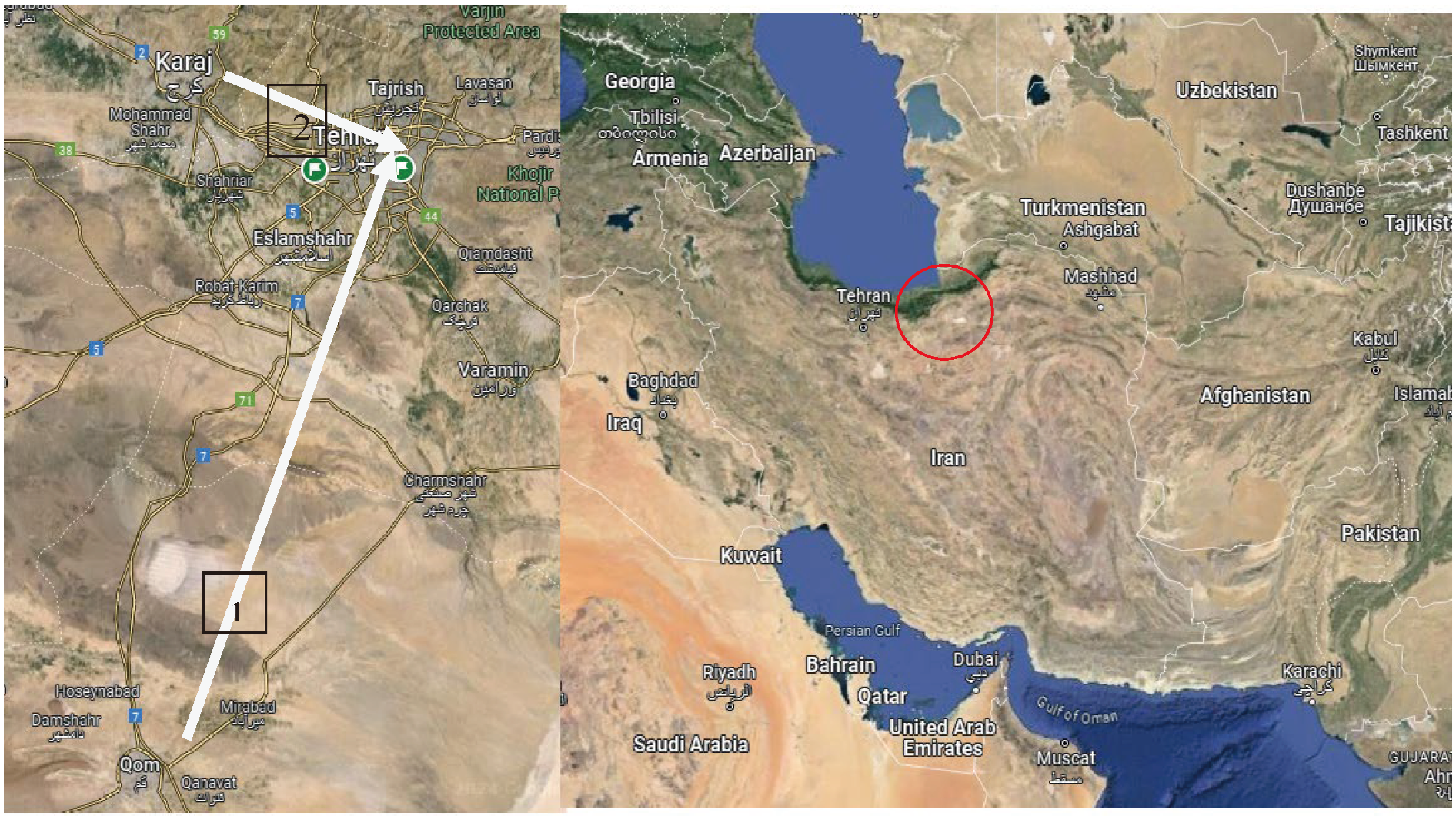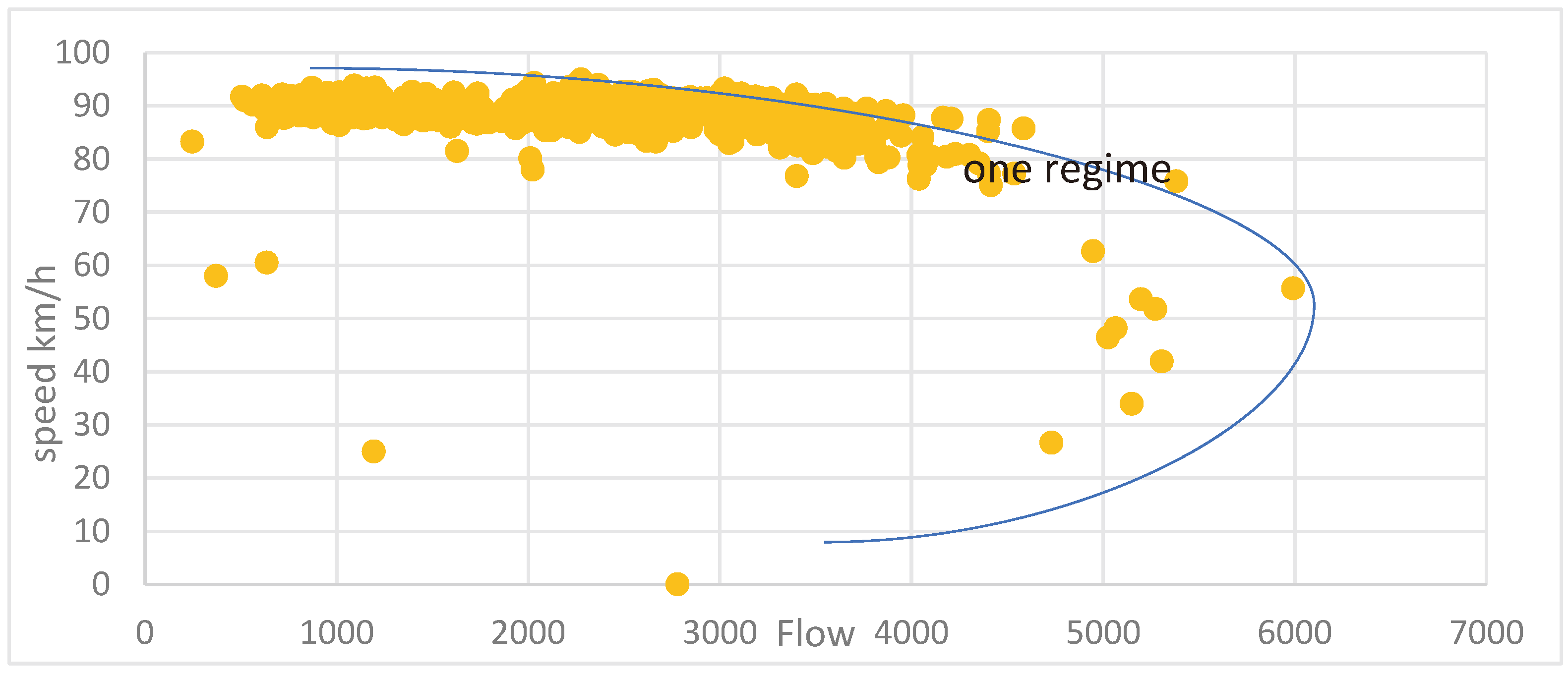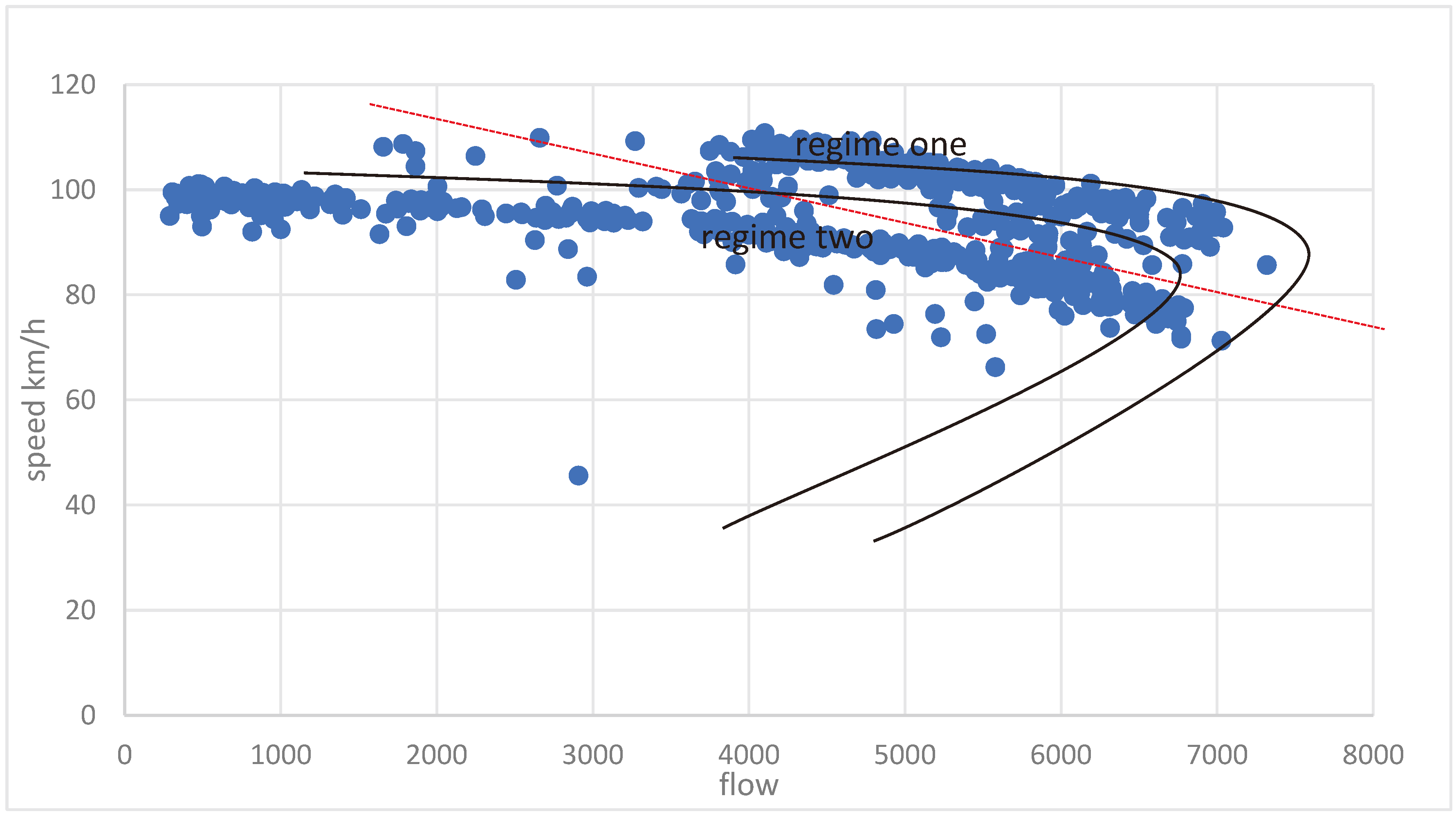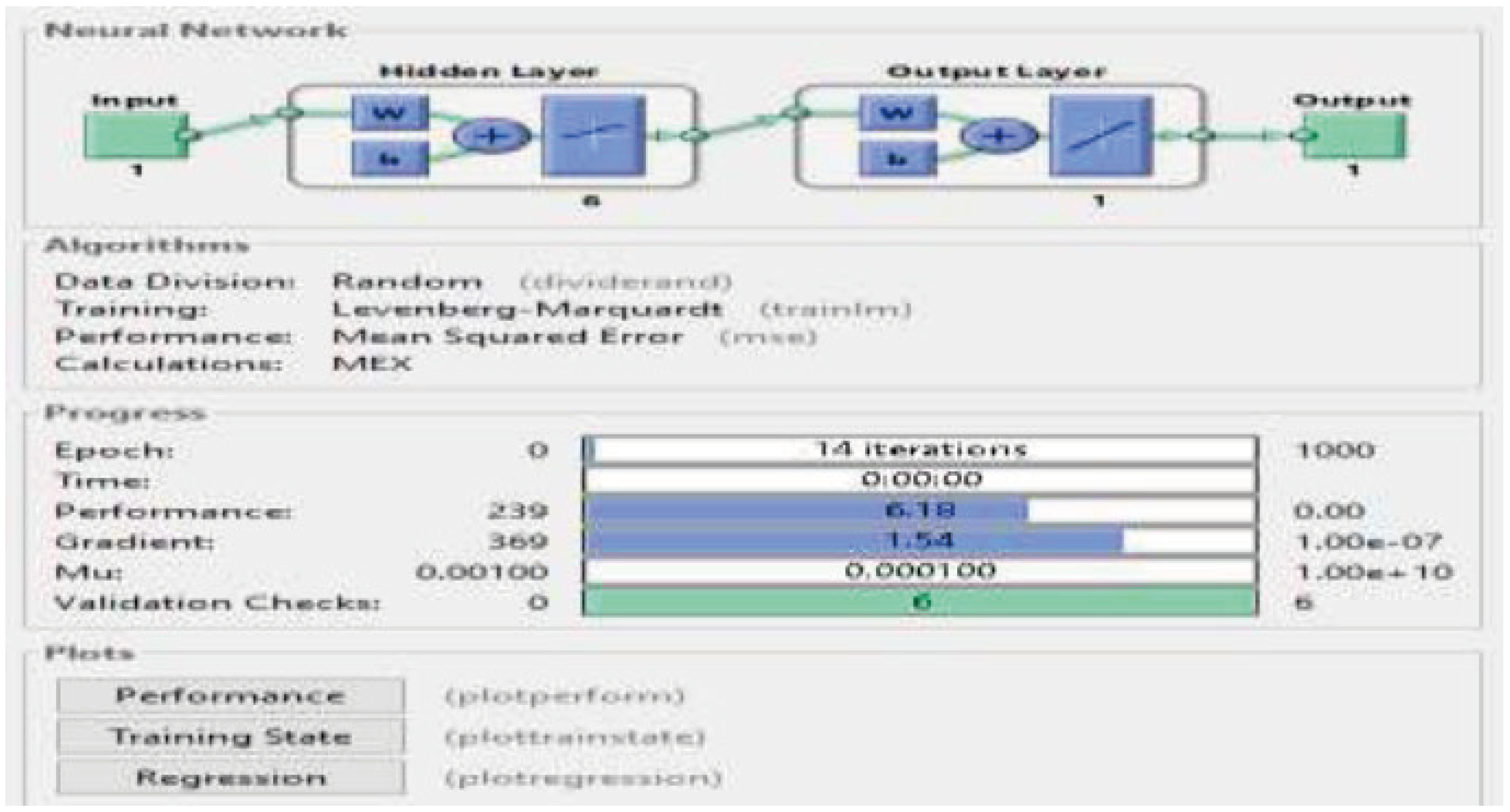1. Introduction
The examination of traffic flow is inherently complex [
1], especially when speeds decrease in congestion scenarios [
2]. To comprehend and measure traffic flow dynamics, three principal methods are utilized. The first method adopts a macroscopic approach [
3], treating flow as a cumulative concept. The second method employs a microscopic perspective [
4], scrutinizing the response of individual vehicles in a non-cumulative manner. The third method, known as the human factor approach, seeks to elucidate the mechanisms by which individual drivers establish their positions relative to other vehicles, thereby contributing to the development of a strategic road system [
5]. The imperative need for analyzing traffic flow and establishing a precise model to determine road capacity and enhance the Level of Service (LOS) has long been recognized [
6]. This process is crucial for calculating trip times across different sections of the road, ensuring efficient transportation systems [
7]. According to the Highway Capacity Manual's definition, highways are classified as uninterrupted flows [
8]. This paper specifically concentrates on modeling uninterrupted traffic flows, aiming to establish the correlation between speed and density on Iran's highways. To achieve this objective, the research is centered on the Karaj-Tehran and Qom-Tehran highways, utilizing traffic data for in-depth calculations. The methodology section outlines the approach taken in data collection and analysis, ensuring a robust foundation for the study. Subsequently, the results section provides insights into the relationship between speed and density on the selected highways. It appears challenging for a single-regime model with three or fewer parameters to precisely capture the intricate relationship in traffic flow dynamics. The primary contribution of this paper lies in unveiling a concealed factor responsible for the inadequacy of single-regime models across diverse traffic states [
9]. Addressing this challenge, the study introduced multi-regime models, demonstrating an enhanced capability to accurately capture the relationships between speed, density, and flow [
10]. Unlike single-regime models, the multi-regime approach acknowledges and accommodates the diverse patterns present in traffic data, offering improved accuracy and a more nuanced representation of the complex dynamics within varying traffic conditions [
11]. This adaptation contributes to a more robust modeling framework, better suited to handle the intricacies associated with different regimes in traffic flow [
12]. In a comprehensive study, it is evident that the predominant focus of traffic data collection for freeways lies in free-flow conditions. For instance, a substantial 86.3% of the dataset represents low densities (<20 veh/km). This emphasizes that the inaccuracies observed in single-regime models cannot be solely attributed to their functional forms; the presence of sample selection bias significantly contributes to these inaccuracies. In essence, the overrepresentation of data collected under free-flow conditions underscores the need to address and mitigate sample selection bias for a more nuanced and accurate understanding of traffic flow dynamics [
9]. Therefore, it can be hypothesized that the better ability of multi-regime models compared to single-regime models is not because the model is better, but because the data used in the model has less dispersion. Enhanced data quality leads to the development of models with reduced error [
13].This paper deals with the modeling of traffic uninterrupted flows. The purpose of this paper is to determine the relationship between speed and density on Iran`s highways. For this purpose, Karaj-Tehran and Qom-Tehran highways were selected and traffic data was used to perform the calculations.
2. Literature Review
Many traffic flow models draw inspiration from fluid flow theory, wave theory and statistical methods. Notably, the initial development of flow models incorporated equations rooted in hydrodynamic theories, marking a groundbreaking departure. The seminal work by Greenshields in 1934 laid the groundwork for understanding the fundamental relation in traffic flow dynamics. Greenshields initially investigated the relationship between two key variables, spacing(s), representing the average distance between the fronts of two consecutive vehicles, and velocity (v), denoting the speed of vehicles. As traffic flow modeling progressed, researchers expanded their exploration beyond the original variables studied by Greenshields. The fundamental relation, originally expressed in terms of spacing and velocity, was subsequently examined using alternative variables such as density (q), representing the average number of vehicles per unit length of road, and flow (q), indicating the average number of vehicles per time unit [
14]. Light Hill, in particular, played a pioneering role by introducing the concept of macro flow behavior in traffic, conceptualizing it as a continuous flow of fluid. Light Hill's contributions are encapsulated in the kinematic waves model, representing a significant advancement in understanding traffic dynamics [
15]. Following Light Hill's groundwork, subsequent researchers, including Phillips [
16] and Pipes [
17], further contributed to the refinement and validation of this model. Phillips and Pipes extended the understanding of traffic flow dynamics by building upon the hydrodynamic framework, incorporating additional insights and considerations [
18]. Greenshields proposed a fundamental linear relationship between flow and concentration [
19]. This relationship is typically expressed through the following Equation (1).
where v
f is Free-flow speed and k
j is the jam density. In 1961, Trying to overcome the limitation of Greenberg’s model, Underwood put forward an exponential model as shown in Equation (5) below. The problem with this model is to maximize the density of the traffic jams
Underwood [
20] has demonstrated a model of the Equation (2).
In Equation (1), Greenberg assumed a logarithmic relationship between speed and density as in Equation (3) that was based on fluid flow theory and v
0 is for optimal speed [
21]. It is assumed that the optimal speed is half the design speed.
Further developments were made with the introduction of a new parameter (n) to provide for a more generalised modelling approach. When n = 1, Pipe’s model resembles Greenshield’s model [
17].
All the aforementioned models operate under the assumption that the same speed-density relation is valid for the entire range of densities observed in traffic streams [
11]. Consequently, these models are referred to as single-regime models. A primary challenge in traffic flow modeling is effectively representing near-capacity conditions, where traditional models frequently encounter difficulties. Despite their simplicity, single-regime models display a notable discontinuity between free-flow and congested states, thereby falling short in capturing the nuanced dynamics near capacity. To overcome this limitation, multi-regime models have emerged, incorporating elements from single-regime approaches but introducing distinct regimes to account for different traffic conditions [
22]. However, multi-regime models face their own set of hurdles [
23]. The main challenge lies in precisely identifying breakpoints between regimes, as slight variations in these points can significantly impact model performance. Moreover, the heightened complexity of multi-regime models often results in higher computational demands, potentially limiting their applicability in real-time scenarios. To address this issue, non-parametric models can offer a viable solution in handling different regimes. In fact, non-parametric smoothing functions can be seen as a generalization of multi-regime models for q(k), where the number of regimes is allowed to vary in a systematic and controlled way [
23].
Despite these challenges, multi-regime models generally exhibit lower mean deviation compared to single-regime models, indicating a closer fit to real-world data. The ongoing development of hybrid models and the integration of advanced data-driven techniques offer promising avenues for overcoming these limitations and achieving more accurate and robust traffic flow modeling, particularly at near capacity. One of the non-parametric models addressing this challenge is the neural network [
24]. However, it is essential to note that proper data filtering is crucial for ensuring the neural network model achieves suitable performance [
13].
4. Result
By plotting the flow velocity for both freeways, it becomes evident that one curve adequately represents the flow for freeway one. However, for freeway two, there is a noticeable distinction, with two discernible regimes, aptly named regime one and regime two. It is noteworthy, the second road connecting the two cities, exhibits a high-density flow both during the day and evening.
Figure 3.
Flow-speed for Tehran - Qom freeway.
Figure 3.
Flow-speed for Tehran - Qom freeway.
The temporal segmentation into two distinct 12-hour periods, from 8 am to 8 pm, introduces a compelling layer to the analysis, revealing the variations in traffic patterns between day and night for both the Tehran-Qom and Tehran-Karaj Freeways. Regime one, associated with daytime flow, and regime two, linked to nighttime flow, showcase distinct characteristics during these timeframes. The red dashed line as a visual demarcation is a valuable addition, effectively partitioning the flow patterns between day and night. This visual cue serves a crucial role in highlighting the precise transition point where the dynamics of traffic flow shift. Its significance lies in providing a clear representation of the temporal distinction between regime one and regime two on the plotted curve for freeway two. By doing so, it enhances the interpretability of the data, enabling readers to discern and analyze the nuanced variations in flow velocity during different periods of the day and night, contributing to a more comprehensive understanding of the freeways' traffic dynamics.
Figure 3.
Flow-speed for Tehran - karaj freeway.
Figure 3.
Flow-speed for Tehran - karaj freeway.
The parameters for each model are acquired using the SPSS software. Subsequently, the model is formulated, and standard deviation along with R2 (R-Squared) values are computed and compared.
For the GreenShield Model, the speed is determined for free flow, reaching up to 93.16 km/h, while the traffic jam density (Dj) is established at a maximum of 153.49 pc/km/ln, as indicated in
Table 3. By substituting these values into Equation (1), the GreenShield model for the Tehran-Qom freeway is derived, as represented in Equation (8). The ensuing analysis involves the assessment and comparison of standard deviation and R2, providing insights into the model's accuracy and effectiveness in capturing the traffic dynamics of the Tehran-Qom freeway.
Continuing the analysis for the Tehran-Karaj highway, Equation (5-2) is obtained, and to streamline the presentation and avoid redundancy, reference is made to the corresponding table (Green Shields Tehran-Karaj).
In the Greenberg's logarithmic model, the necessity for free-flow speed is alleviated, and the crucial parameter becomes the optimal speed denoted c. For the Tehran-Qom freeway, this optimal speed is determined to be 3.9 km per hour. Additionally, the density of traffic jam tends towards infinity. The formulated equation for the Tehran-Qom freeway is presented in Equation (10). Here, S represents the speed, c is the optimal speed parameter, Dj denotes traffic jam density, and D is the traffic density.
Similarly, for the Tehran-Karaj highway, the optimal speed parameter (c) is found to be 3.4 km per hour, and the traffic jam density tends towards infinity, as indicated in Equation (11).
Table 4.
SPSS software output for the GreenShields model of Tehran -Qom.
Table 4.
SPSS software output for the GreenShields model of Tehran -Qom.
| Parameter Estimates |
|---|
| Parameter |
Estimate |
Std. Error |
95% Confidence Interval |
| Lower Bound |
Upper Bound |
| D |
35366937919.836 |
56882385717.037 |
-76311945740.05 |
147045821579.72 |
| c |
3.945 |
.287 |
3.381 |
4.508 |
In the Pipes Model, which shares similarities with the GreenShields model, an exploration with different values of the exponent n (specifically n=4,3,2,1) has been conducted. According to the findings presented in
Table 5, the best regression line is achieved when n=4, yielding a free-flow speed (S
f) of 89 km/h and a traffic jam density parameter (K
j) of up to 31.6 pc/km/h for the Tehran-Qom Freeway. Substituting these values into the model equation results in Equation (12). For the Tehran-Karaj Freeway, the optimal parameters are S
f =98.5 km/h and K j =43.6 pc/km/ln, as indicated in the same model equation.
In the Underwood's exponential model, two crucial parameters, namely the free-flow speed (S
f) and optimal density (D
o), are obtained through the utilization of SPSS software, as detailed in
Table 6. It is noted that, to streamline the presentation, the specific table for the Tehran-Karaj Freeway is not reiterated. For the Tehran-Qom Freeway, the free-flow speed is determined to be 87 kilometers per hour, and the optimal density is indicated as infinite, signifying a limitation in this model Similarly, for the Tehran-Karaj Freeway, the parameters are S
f =94.8 km per hour D
o =∞.These equations encapsulate the Underwood's exponential model for the Tehran-Qom and Tehran-Karaj freeways, respectively.
In this model utilizing a multi-layer perceptron (MLP), the Neural Network for both the Tehran-Qom and Tehran-Karaj Freeways is designed with specific characteristics. In
Figure 4, the architecture of the network is illustrated, featuring two internal layers. The first layer employs a sigmoid function (logistic function), while the second layer utilizes a linear function. The training process employs the TrainLM training function in MATLAB2016, and the performance evaluation is based on the Mean Square Error (MSE) function
The results of various models are consolidated in
Table 7. The findings in this table reveal that the R2 (coefficient of determination) for the neural network model stands out significantly, surpassing the R2 values of other models. This enhanced R2 can be attributed to the low standard deviation of the data for the neural network, indicating the model's robustness and ability to capture the intricate patterns within the freeway's traffic dynamics. The overall analysis suggests that the neural network model outperforms other models, establishing it as the most effective model for both the Tehran-Qom and Tehran-Karaj Freeways.
In Figure 3, it is evident that the traffic flow on the Tehran-Karaj freeway exhibits two distinct regimes. Subsequently, the data was partitioned into two categories, day and night, leading to a reevaluation of the modeling process. Notably, there has been a substantial improvement in the fit of the model. The results (
Table 8) specifically pertain to the Tehran-Karaj freeway, indicating that the modeling adjustments based on the day and night categories have contributed significantly to enhancing the accuracy and effectiveness of the traffic flow model for this specific freeway section.
Table 9 provides an overview of the change in R-Square values for different traffic flow models applied to the Tehran-Karaj freeway, considering both one regime and two regimes. This table offers a breakdown of R-Square values for each model, emphasizing distinctions between day and night regimes.
5. Discussions
Single-regime models employ a single mathematical function to depict the relationship between speed, flow, and density across all traffic conditions [
9]. In contrast, Multi-regime models utilize distinct functions for different regimes, offering a more accurate portrayal of the intricate relationship within traffic flow characteristics. Identifying these regimes often involves analyzing data based on speed, flow, and density. Methods such as clustering or density-based approaches are commonly employed for regime identification. For instance, a study applied a probabilistic approach with a hidden Markov model to describe similar density characteristics on a freeway [
27]. Researchers strategically partitioned traffic flow data into distinct regimes, developing individualized models for each pattern, emphasizing the strategic significance and adaptability of a multi-regime strategy for enhancing forecasting precision [
27,
28].
The paper highlights a notable shift in R-Square values for various models when transitioning from one regime to two regimes, specifically during day and night periods. The Neural Network Model particularly excels, showcasing substantial improvements in R-Square for both day and night regimes. The distinction between day and night data allows for a nuanced evaluation of each model's performance across different time frames. Models like GreenShields, Greenberg, Pipes, and Underwood exhibit noteworthy enhancements in R-Square values for both day and night, demonstrating their adaptability to diverse traffic patterns. The change in R-Square provides valuable insights into the improved model fit after accounting for distinct regimes. A higher change in R-Square signifies enhanced explanatory power over observed traffic flow data. The consistent high performance of the Neural Network Model underscores its adaptability and proficiency in capturing intricate relationships within traffic dynamics, particularly evident in the two-regime scenario. The study suggests that considering distinct regimes, especially during day and night, significantly enhances modeling accuracy for freeways. These findings have practical implications for traffic management and planning, emphasizing the importance of understanding variations throughout the day for effective decision-making in traffic-related scenarios.










